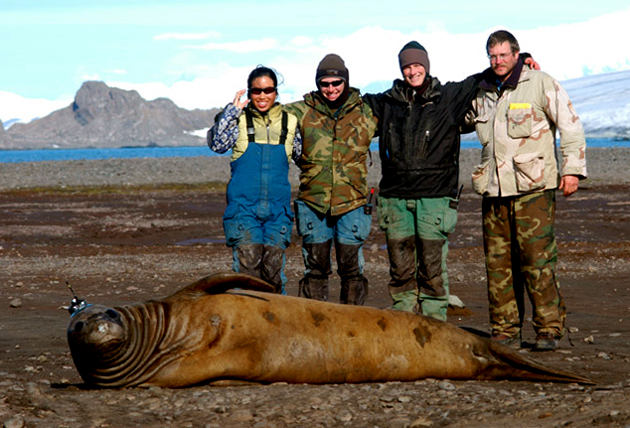|
Keeping trackCape Shirreff project follows seals to learn about ecology, oceanographyPosted November 26, 2008
Mike Goebel On the high-tech end, he can examine changes in diet through molecular signatures in the animal’s milk. The low-tech method requires hiking around Livingston Island off the Antarctic Peninsula and looking at the remains in the animal’s scat. On the Peninsula
“That data are very biased as you might imagine: it’s basically the last meal, the last day of foraging,” explained Goebel, a biologist with the National Oceanic and Atmospheric Administration (NOAA) The interest in diet isn’t simply for curiosity’s sake. The study is part of NOAA’s Antarctic Marine Living Resources (AMLR) CCAMLR is an international treaty to conserve and manage the marine living resources around Antarctica. To help achieve that goal, the AMLR program provides data on the region’s top predators, from seals to penguins In addition to the project on Livingston, where the researchers work out of a permanent camp at Cape Sherriff, NOAA scientists also conduct research on King George Island and aboard a Russian research vessel each year. The National Science Foundation (NSF) “A lot of our research is very krill-centric, and looks at elements of the ecosystem and how they’re changing in relation to how krill are changing,” explained Goebel, referring to the small crustaceans that make up the foundation of the Southern Ocean Krill “As part of that, we have to be able to sort out what changes are the result of environmental changes that have nothing to do with fisheries but may be linked, for instance, to climate change or warming of the peninsula region,” Goebel explained. NOAA colleagues on King George Island at the Copacabana field camp were among the first ones to link climate change with declines in krill and penguin populations. That study dates back to the late 1970s. NOAA opened the Cape Shirreff camp about 10 years ago when it expanded the AMLR program. Goebel said it is difficult to tease out what changes in the populations may be caused by fishery activities versus climate change and natural variability on the shorter time scale at Livingston. For example, the researchers have linked differences in the fur seal diet with the Antarctic Circumpolar Current (ACC) The ACC is rather like “a river without boundaries” that fluctuates in location year to year, Goebel explained. When it’s far from the island and outside the range of where the seals forage, polar species dominate the predators’ diet. But when the ACC moves closer, more warm-water species may be on the dinner menu. In addition to fur seals, the team studies elephant and leopard seals, as well as seabirds and fish. Goebel is also a co-principal investigator on an NSF-funded project with Daniel Costa from University of California-Santa Cruz “Because we and our colleagues in other national programs are putting them on at sites all around the Antarctic, we have circumpolar coverage of areas of the ocean that are very difficult to get oceanographic information on,” Goebel said. “Oceanographers are very excited about the kind of data we’re now getting from elephant seals.” The AMLR project on Livingston uses similar technology in the summer, with microprocessors measuring dive depths of animals and water temperature. The satellite-linked transmitters provide information on how far the seals forage for food. Tagged animals offer data on winter survival rates and the number of young who return to the island to breed. “They’re always coming back to the same place; they always come back to Cape Shirreff,” Goebel said, as the animals show a high degree of loyalty to their breeding colony. “Most of my research is a direct result of our need for understanding krill in the ecosystem and how it relates to [the seals’] reproductive success.” NSF-funded research in this story: Daniel Costa, University of California-Santa Cruz, and Mike Goebel, NOAA, Award No. 0440687 |



For USAP Participants |
For The Public |
For Researchers and EducatorsContact UsU.S. National Science FoundationOffice of Polar Programs Geosciences Directorate 2415 Eisenhower Avenue, Suite W7100 Alexandria, VA 22314 Sign up for the NSF Office of Polar Programs newsletter and events. Feedback Form |




